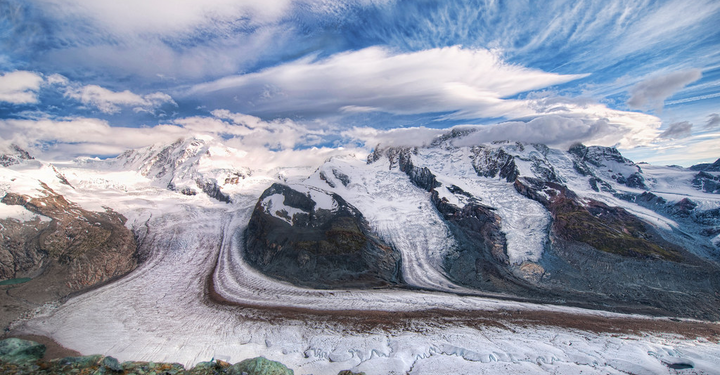The world’s glaciers are rapidly melting due to the planet’s increasing warming caused by greenhouse gas emissions, with the mean global glacial mass loss estimated at 2% between 2010 and 2020.
Glaciers in the Alps, meanwhile, recorded a 1.2% mass loss between 2000 and 2014.
A new study, published in Nature Ecology and Evolution on May 4, 2023, assessed the damaging impact of glacier retreat on Alpine river habitats.
As the researchers explain, they “projected glacial losses between 2020 and 2100 to assess what impact the changing input of meltwater into alpine rivers would have on the distribution of 15 species of invertebrate, such as stoneflies, non-biting midges, flatworms and mayflies.”
The study focused on invertebrates because of their vital roles in nutrient cycling; they are prey for other species such as fish, amphibians, birds and mammals, which means that through them, organic matter is transferred through the food chain. Therefore, they are “crucial for wider Alpine ecosystems,” as the study explains.
The study discovered that Alpine rivers “will experience major change by the end of the century.” After 2040, the rivers will flow slower and become more prone to erosion, and will also become drier and warmer. It is possible that some streams could endure periods where water does not flow at all.
As a result, some species that are adapted to these rivers will be completely eradicated by these changes and will disappear from the Alps while several other species will be forced to migrate to higher parts of the Alps where glacial melting is less extreme. Although most species are predicted to suffer decreases in suitable habitat area across the European Alps by 2100, glacial melting will have a particularly extreme impact on invertebrates.
Related Articles: Could the Rate at Which Glaciers Are Melting Cause the Next Pandemic? | 50,000 Years Later: Ancient ‘Zombie Viruses’ Resurface in Melting Arctic
For example, some non-biting midges such as the species Diamesa steinboecki will be forced to relocate to avoid extinction, due to the very rare conditions of the current meltwater rivers that these midges thrive in.
However, the study emphasised that there are both “winners” and “losers” when it comes to this changing habitat. The flatworm Crenobia alpina, for example, may benefit from the changes, because it thrives in warmer water and more stable flow levels.
The map below shows the predicted change in habitat areas for some invertebrate species within river sub-catchments of the European Alps between 2020 and 2100, illustrating how each species will be impacted differently by the changes.
As the map shows, forced relocation will impact many invertebrate species in the next century, as they fight to find cold-water rivers in which they can thrive.
However, despite higher and colder parts of the Alps potentially being suitable to refuge migrating species, winter tourism and activities such as skiing are also likely to increase in these areas. In addition, the decline of glacial rivers may be an opportunity for an increase in hydropower stations in these higher areas. Consequently, human interference in the Alps may also endanger these migrating species.
The high Alpine areas, which are crucial for the survival of migrating species that have been displaced due to the changing meltwater rivers, are currently not protected and are not included within national park boundaries, according to some of the study’s authors. This must change if these Alpine invertebrate species are to live on — and they must live on if we want to avoid damage to the entire food chain and ecosystem.
It is therefore essential that conservation strategies are put in place to protect the threatened Alpine biodiversity from even more damage caused by human activities.
Editor’s Note: The opinions expressed here by the authors are their own, not those of Impakter.com — In the Featured Photo: Glaciers of the Alps. Featured Photo Credit: Trey Ratcliff.










